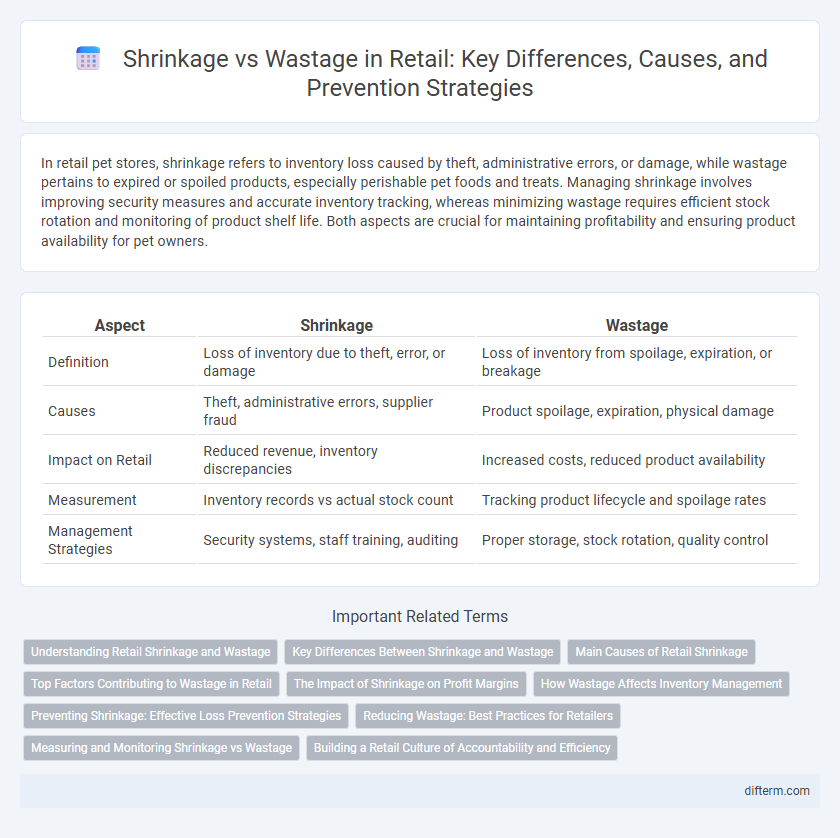In retail pet stores, shrinkage refers to inventory loss caused by theft, administrative errors, or damage, while wastage pertains to expired or spoiled products, especially perishable pet foods and treats. Managing shrinkage involves improving security measures and accurate inventory tracking, whereas minimizing wastage requires efficient stock rotation and monitoring of product shelf life. Both aspects are crucial for maintaining profitability and ensuring product availability for pet owners.
Table of Comparison
| Aspect | Shrinkage | Wastage |
|---|---|---|
| Definition | Loss of inventory due to theft, error, or damage | Loss of inventory from spoilage, expiration, or breakage |
| Causes | Theft, administrative errors, supplier fraud | Product spoilage, expiration, physical damage |
| Impact on Retail | Reduced revenue, inventory discrepancies | Increased costs, reduced product availability |
| Measurement | Inventory records vs actual stock count | Tracking product lifecycle and spoilage rates |
| Management Strategies | Security systems, staff training, auditing | Proper storage, stock rotation, quality control |
Understanding Retail Shrinkage and Wastage
Retail shrinkage primarily refers to the loss of inventory due to theft, administrative errors, or supplier fraud, directly impacting profit margins. Wastage, on the other hand, involves the deterioration or spoilage of products, often caused by improper handling, expiration, or damage during storage and transportation. Effective management of shrinkage and wastage through inventory control systems and employee training can significantly enhance retail profitability and operational efficiency.
Key Differences Between Shrinkage and Wastage
Shrinkage in retail refers to the loss of inventory due to theft, fraud, or administrative errors, while wastage specifically relates to the loss of perishable goods because of spoilage or damage. Shrinkage impacts the overall store inventory negatively without necessarily indicating product expiration, whereas wastage is tied directly to product lifecycle and quality control. Understanding these distinctions helps retailers implement targeted loss prevention strategies and optimize supply chain management.
Main Causes of Retail Shrinkage
Retail shrinkage primarily stems from employee theft, which accounts for nearly 35% of losses, followed by shoplifting responsible for about 25%. Administrative errors and vendor fraud contribute significantly, making up an estimated 20% and 10% of shrinkage respectively. Inventory management issues and damaged goods also play roles but are more aligned with wastage rather than shrinkage.
Top Factors Contributing to Wastage in Retail
In retail, wastage primarily arises from factors such as perishable goods exceeding their shelf life, improper handling during storage and transportation, and unsold seasonal inventory. Inefficient inventory management systems lead to overstocking, which increases the likelihood of product expiration and markdowns. Employee errors in labeling, damage during stocking, and retail theft also significantly contribute to increased wastage levels.
The Impact of Shrinkage on Profit Margins
Shrinkage in retail, including theft, administrative errors, and supplier fraud, directly reduces profit margins by increasing unaccounted losses compared to wastage, which primarily involves perishable goods spoilage. Retailers face an average shrinkage rate of 1.38%, translating to billions of dollars in lost revenue annually, significantly undermining operational profitability. Implementing advanced inventory management systems and loss prevention strategies is crucial to minimizing shrinkage and protecting the bottom line.
How Wastage Affects Inventory Management
Wastage in retail inventory management leads to inaccurate stock levels, causing difficulties in demand forecasting and order planning. Excess product deterioration or spoilage increases carrying costs and reduces available inventory for sale, directly impacting profitability. Implementing waste reduction strategies enhances inventory accuracy and supports efficient supply chain operations.
Preventing Shrinkage: Effective Loss Prevention Strategies
Preventing retail shrinkage requires implementing comprehensive loss prevention strategies such as advanced inventory tracking systems, employee training programs, and surveillance technologies. Leveraging data analytics helps identify patterns of theft and operational inefficiencies, allowing targeted interventions that reduce both external and internal shrinkage. Effective shrinkage prevention minimizes financial losses, improving overall profitability and operational sustainability within retail environments.
Reducing Wastage: Best Practices for Retailers
Implementing advanced inventory management systems helps retailers accurately track stock levels and expiration dates, significantly reducing wastage. Training staff on proper handling, storage techniques, and portion control minimizes product damage and spoilage throughout the supply chain. Leveraging data analytics enables proactive identification of slow-moving items, allowing timely promotions or stock adjustments that prevent excess inventory from becoming waste.
Measuring and Monitoring Shrinkage vs Wastage
Accurately measuring shrinkage and wastage in retail requires precise inventory tracking and loss reporting systems that differentiate between theft, administrative errors, and product spoilage. Implementing real-time data analytics and regular audits enables retailers to monitor shrinkage rates against wastage trends, providing actionable insights for loss prevention strategies. Leveraging technology such as RFID and automated inventory management further enhances the ability to identify shrinkage sources and optimize stock control.
Building a Retail Culture of Accountability and Efficiency
Retail shrinkage, typically caused by theft, errors, and fraud, directly impacts profitability and requires stringent loss prevention strategies. Wastage, often stemming from overstocking, spoilage, or improper handling, demands efficient inventory management and staff training to minimize product loss. Building a retail culture of accountability and efficiency hinges on transparent reporting systems, employee engagement programs, and continuous process improvements to balance shrinkage reduction and wastage control.
shrinkage vs wastage Infographic

 difterm.com
difterm.com